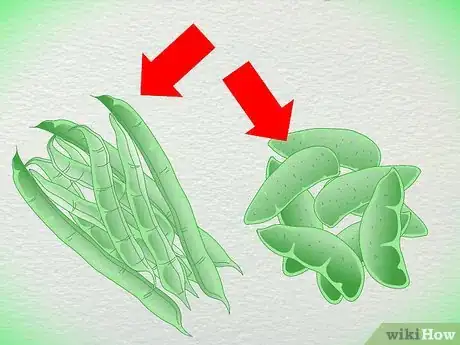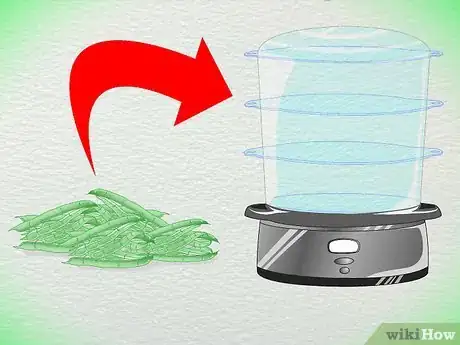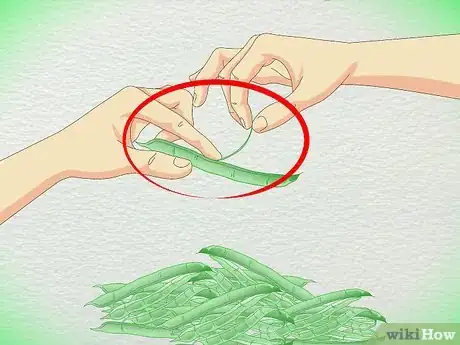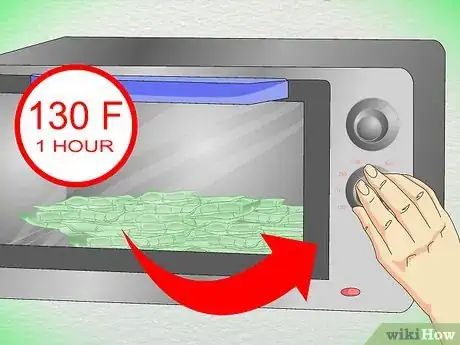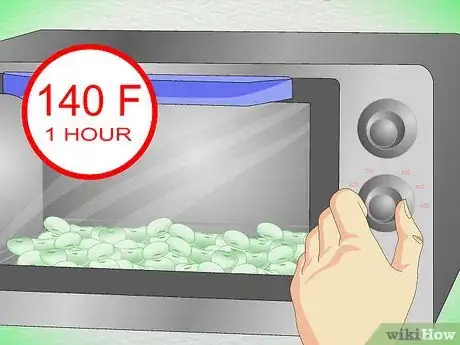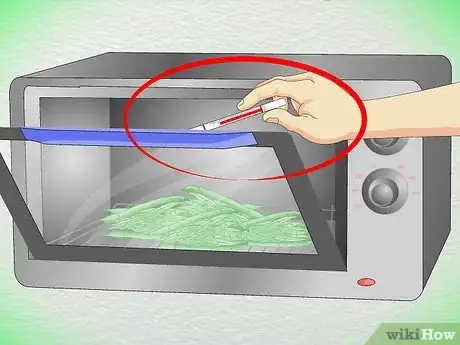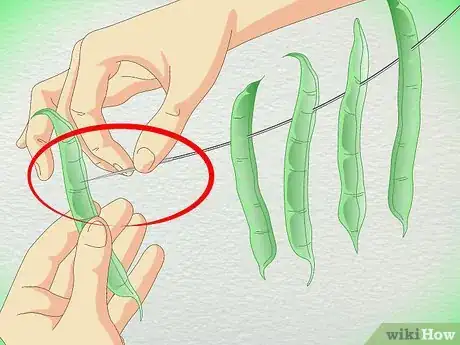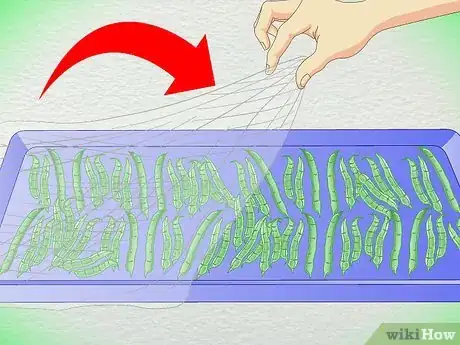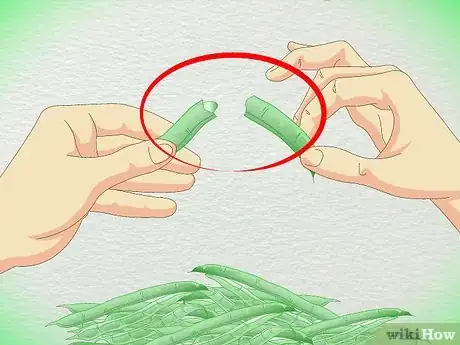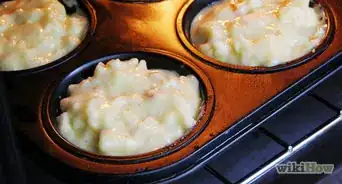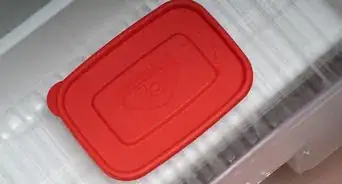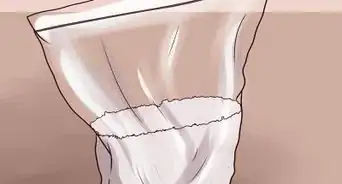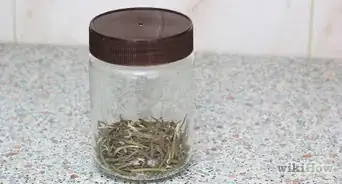X
wikiHow is a “wiki,” similar to Wikipedia, which means that many of our articles are co-written by multiple authors. To create this article, 12 people, some anonymous, worked to edit and improve it over time.
This article has been viewed 134,048 times.
Learn more...
If you grow beans or buy them in bulk, you may wish to dry them so they are preserved for future use. Below are some ways to dry beans yourself.
Steps
Method 1
Method 1 of 5:
Steaming Method
-
1(Steaming Method)Determine what type of beans you wish to dry. The drying conditions for string beans, for example, are different from the drying conditions for lima beans.
-
2Choose your equipment and method for drying beans. It is possible to dry beans either indoors or outdoors, depending on your budget and even your geographic location, so there may be multiple ways you can dry beans. Using a store-bought dehydrator, your kitchen oven, or the heat of the sun are all ways to dry beans.Advertisement
-
3Prepare your beans as needed and steam them before drying them.
- Remove the strings from green, snap, string, or wax beans. For larger bean varieties, split pods lengthwise to allow for faster drying.
- Shell full-grown lima beans, peas, or other shell beans. "Full-grown" means past the time these beans would be picked for eating at the table, canning, or preserving, but before the pods are dry.
- Steam no more than 2 inches (5.1 cm) of green, snap, string, or wax beans in a wire rack or basket above a pot (or kettle) of boiling water for 15 to 20 minutes.
- Steam shallow layers of lima or shell beans in the same way for 10 minutes.
- Take batches of beans out of the rack or basket and spread them on paper towels or clean cloths to absorb extra moisture. Cover the steamed beans with towels while they wait to be moved onto drying trays.
-
4Spread steamed beans on drying trays that are slatted, perforated, or woven on the bottom. These openings will allow air to circulate through and carry away evaporating moisture while the beans dry.
- Depending on their size, green, snap, string, or wax beans should be spread in 1 layer or 1/2 inch (1.25 cm) deep per tray. Lima or other shelled beans should be spread thinly on the trays.
Advertisement
Method 2
Method 2 of 5:
Oven Method #1
-
1Dry 1 or 2 trays of whole green, snap, string, or wax beans at 120 F (49 C) for 1 hour. Increase the temperature to 150 F (66 C) until the beans are nearly dry, then lower the heat to 130 F (54 C).
-
2Dry split green, snap, string, or wax beans at 130 F (54 C) for 1 hour. Raise the temperature to 150 F (66 C), and then return it to 130 F (54 C) when the beans are almost dry.
-
3Dry lima beans or other shelled beans at 140 F (60 C) for the first hour. Gradually increase the heat to 160 F (71 C) until the beans are nearly dry, then reduce the temperature to 130 F (54 C).
Advertisement
Method 3
Method 3 of 5:
Oven Method #2
-
1Maintain an oven temperature of 140 F (60 C) as best you can for either shelled or long beans until the beans are dried. You may need to set your oven to its "warm" setting or lowest temperature and then leave the oven door ajar. You can also put the lowest tray at least 8 inches (20 cm) from the oven's bottom heat source.
-
2Monitor the temperature with a food thermometer if needed.
-
3Lower the temperature by 10 F (5.6 C) or briefly turn off the oven as necessary to prevent beans from scorching, cooking or caramelizing.
Advertisement
Method 4
Method 4 of 5:
String & Air Dry Method
Method 5
Method 5 of 5:
Sunlight Method
-
1Spread steamed beans on trays as for indoor drying.
-
2Cover the beans with cloth netting that has a mesh no bigger than 1/2 inch (1.25 cm). This protects them from insects and air-borne debris.
-
3Put the trays of beans in direct sunlight on top of a platform or some other arrangement such as spaced bricks that will allow air to circulate underneath the trays.
-
4Stir the beans gently with your fingers several times a day to help them dry evenly.
-
5Stack the drying trays of beans under a shelter and cover them with a carton or clean sheet to protect the beans from dew at night. Alternatively, you can consider bringing the trays indoors at night. If you know the night air will be very dry, covering the outdoor trays is not necessary.
-
6Place the drying trays in the sun the next day after uncovering them if needed.
-
7Test for dryness after the beans have cooled from the second day of drying. Green, snap, string, or wax beans are dry enough when they look and feel brittle. Lima or shell beans are dry enough when they look and feel hard, brittle, and break cleanly when they are broken.
Advertisement
Community Q&A
-
QuestionDo I need to blanch before drying them in the oven? I put mine straight in the oven after podding.
 Community AnswerVegetables with long cooking times, like beans, should be blanched. It stops the enzyme action that causes flavor loss, reduces microorganisms that cause spoilage, preserves color, and generally makes produce dry faster because the outer skin becomes more porous. Blanching times are from 2 to 4 minutes, depending on the kind of bean.
Community AnswerVegetables with long cooking times, like beans, should be blanched. It stops the enzyme action that causes flavor loss, reduces microorganisms that cause spoilage, preserves color, and generally makes produce dry faster because the outer skin becomes more porous. Blanching times are from 2 to 4 minutes, depending on the kind of bean. -
QuestionDo I clean the beans before drying?
 Community AnswerYes, you can.
Community AnswerYes, you can. -
QuestionWhen do I pick and how do I dry shelled beans like bingo or pinto beans?
 Community AnswerAllow pods to dry on the vine if possible. If extended wet weather is expected, pull the plants and allow to hang upside down from a clothes line or rope, or pick when the skin is at or past the "leathery" stage and dry in a food hydrator (90-120 degrees) for two or three hours. Check and remove brittle pods, then continue drying until complete. Shell in the usual manner.
Community AnswerAllow pods to dry on the vine if possible. If extended wet weather is expected, pull the plants and allow to hang upside down from a clothes line or rope, or pick when the skin is at or past the "leathery" stage and dry in a food hydrator (90-120 degrees) for two or three hours. Check and remove brittle pods, then continue drying until complete. Shell in the usual manner.
Advertisement
Warnings
- Do not keep beans out in full sun all day if drying them outdoors. It could cause them to "case-harden," or form a crust on the outside and prevent the inside from drying properly.⧼thumbs_response⧽
- Never use tray frames made of aluminum, copper, galvanized metal or non-food-grade plastic for the purpose of drying food.⧼thumbs_response⧽
- Do not use your oven's broiling (upper) element if drying beans in the oven. Deflect any heat seen from the oven's broiling (upper) element by putting a cookie sheet on a rack in the highest shelf position.⧼thumbs_response⧽
Advertisement
Things You'll Need
- Water
- Pot or kettle with lid
- Wire rack or basket
- Paper towels or cloth
- Drying trays
- Cloth netting
- Spaced bricks or other raised surface
- Clean sheets or carton
- Dehydrator or oven
- Food thermometer
- Clean string
- Sewing needle
- Dry, well-aired room
References
- Janet Greene, Ruth Hertzberg, and Beatrice Vaughan, Putting Food By (New York: Plume, 2010) 364-374, 376-377, 379-380, 388-389.
- The Gardeners and Farmers of Terre Vivante. Preserving Food Without Freezing or Canning: Traditional Techniques Using Salt, Oil, Sugar, Alcohol, Vinegar, Drying, Cold Storage, and Lactic Fermentation (White River Junction: Chelsea Green Publishing, 1999) 44.
- http://www.uga.edu/nchfp/how/dry/csu_dry_vegetables.pdf
- http://www.uga.edu/nchfp/publications/uga/uga_dry_fruit.pdf
About This Article
Advertisement
